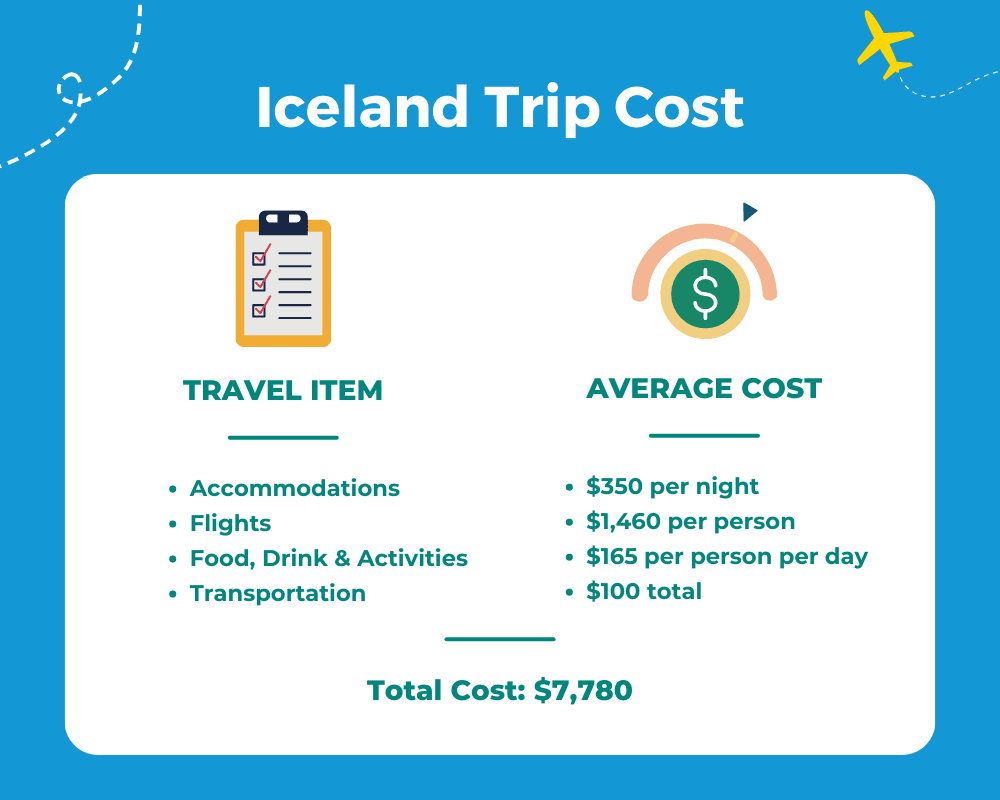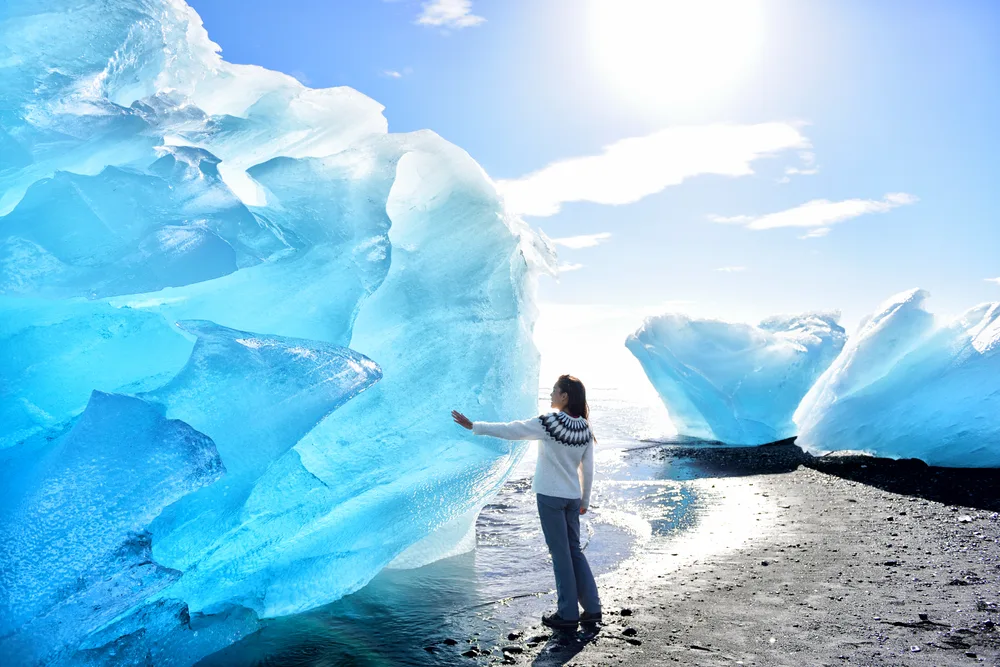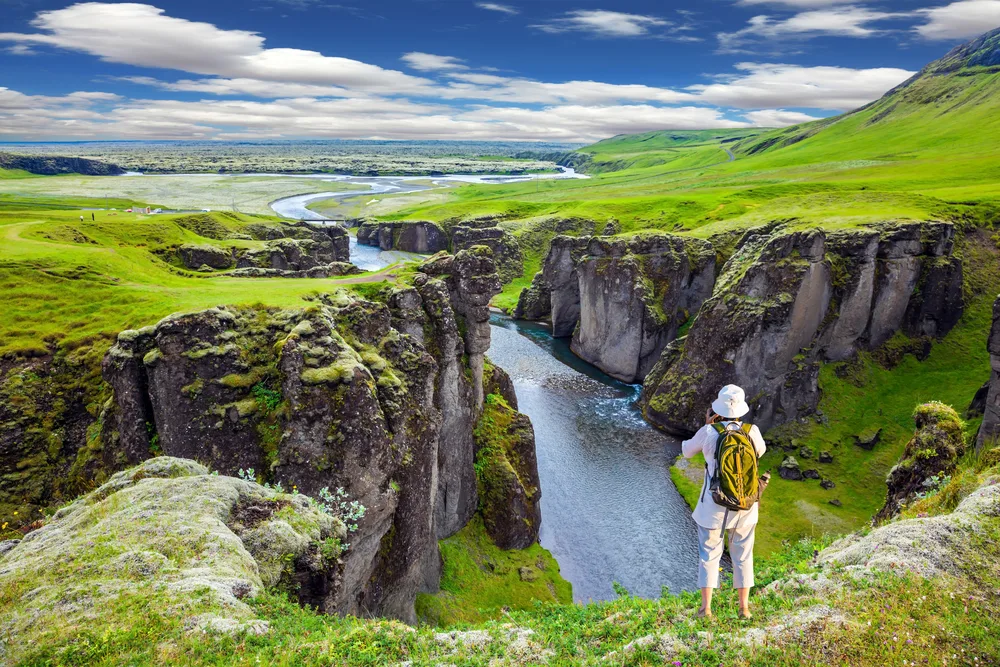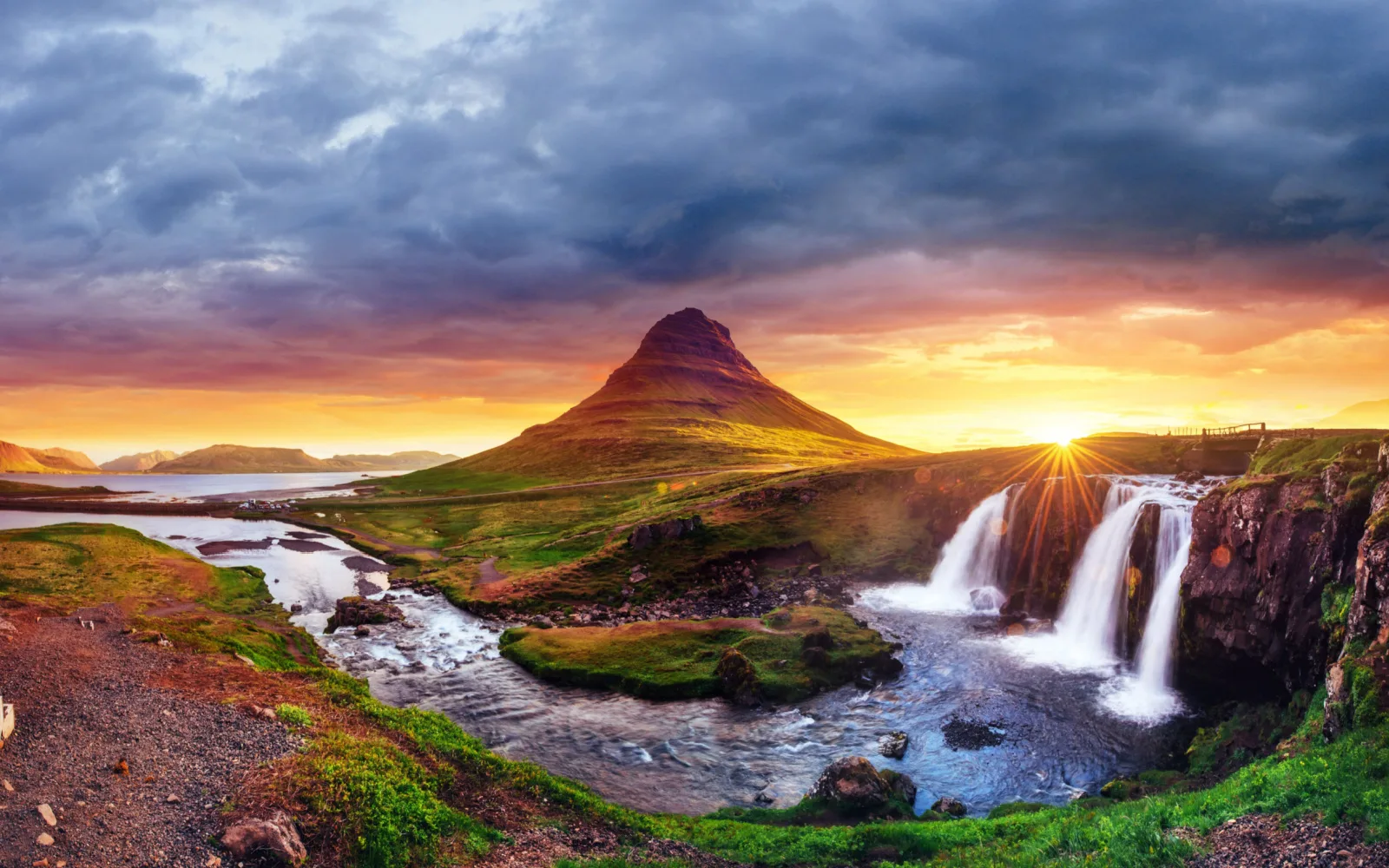True wonder and adventure await in Iceland. Mesmerizing views of the Northern Lights, relaxing soaks in a geothermal spa and a whirlwind trip around the Golden Circle are just a taste of what this country has to offer.
Before you can embark on that unforgettable journey, you’ll need to first explore what a trip to Iceland costs. The answer varies, of course, depending on how you envision your trip. Do you want to camp out under the stars? Your budget will look much different from those looking for a romantic getaway at a luxury resort.
We’ve taken the guesswork out of budgeting for your trip to Iceland by creating this cost guide. Dive in to explore how much your trip might cost and where you can save a bit of money on your travels.
Average Trip to Iceland Cost in 2024

The average cost of a one-week trip for two to Iceland in 2023 costs around $7,800.
- Average Accommodation Cost: $350 per night
- Average Flight Cost: $1,460 per person
- Food, Drink, & Activities: $165 per person, per day
- Transportation: $100
- Total Cost: $7,780
Iceland truly allows you to choose your own adventure. So, these average costs differ from person to person. Where you’re traveling to and from and your ideal places to stay can affect the total cost the most.
Traveling from the East Coast costs much less than departing from the West Coast, especially if you want a direct flight. Most international flights go to Reykjavik Airport. If you want to travel to the other major areas, you can connect to domestic flights or hop on the Flybus.
As for accommodations, The Retreat at Blue Lagoon offers the ultimate luxury resort experience, but it comes with a price tag to match its opulence. On the other hand, tent camping costs little more than your gear and a small nightly fee to immerse yourself in the countryside.
Want the best of both worlds? Treat yourself to a luxury motorhome rental. You can explore the picturesque landscapes by day and then relax in style all night long.
Iceland Trip Cost: Average by Item

Maridav/Shutterstock
Your travel preferences will play a big role in what your trip might cost. But you can get a good idea about what expenses to expect by exploring the following sections.
Accommodation Costs
Where you’d like to stay on your travels can greatly affect the total cost of your trip. On average, Iceland accommodations cost $350 per night. But the price ranges from $20 a night for campers to $1,600 or more for each day spent at a luxury resort.
If you’re traveling on a budget — and the weather cooperates — tent camping may fit the bill. Each night in the campground costs about $20. Showers and Wi-Fi service add $10 per day.
When it’s particularly cold or stormy out, you might be better off grabbing a bed at a hostel for $55 a night or renting a campervan for $90 per day. Alternatively, it’s easy to find cozy Airbnb rentals for $145 per night.
For $200 a night on average, basic hotels offer convenient access to all the best places to see, do and experience in each city. High-end hotels like The Reykjavik EDITION start their room prices at $670.
If you have the funds for luxury accommodations but still want to camp out, rent a luxury motorhome instead for around $400 a day. Even more luxury awaits at resorts like The Retreat at Blue Lagoon for $1,590 and up per night. If you’d like their Romantic Getaway package, it’s $4,115 for the lucky couple to enjoy two days of pampering.
Flight Costs
Summer is the peak travel season in Iceland and for good reason. It has the mildest weather and up to 24 hours of daylight, keeping the fun going all night long. According to the Icelandic Tourist Board, more than 650,000 international travelers visit each summer, driving up flight prices during that time.
If you’d like to save money on your travels, visit in the winter for flights as low as $270 per person. Otherwise, your plane tickets may cost about $1,460 each with layovers. Ticket prices vary wildly depending on where you’re flying out from. From New York, it’s $665 each, while travelers in Alaska may pay $2,200 per ticket.
Direct flights cost even more. The direct routes may save you up to eight hours on the plane, making them the more convenient option by far. Ticket prices can more than double, though, and really cut into your travel budget.
International flights go to Reykjavik Airport most often. A connecting flight can take you to Keflavik, Akureyri or Egilsstadir airports for around $100 a ticket. Taking the Flybus instead can save you about $50 each.
Food, Drink, & Activity Costs
The sky is the limit in what you might spend on food, drinks and activities while visiting Iceland. But if you keep things reasonable, it may cost around $165 per person each day you’re there.
Saving money is as easy as buying groceries from supermarkets like Kronan and Bonus. For about $25, you can get bread, peanut butter, honey, fresh produce and drinks. You’ll also want to keep those items on hand while on the road because stores are few and far between in many areas.
Barring that, you can get hot dogs and sandwiches from gas stations for about $5 each, and they’re pretty good, too. Eating out at casual dining restaurants costs about $30 per person, which can add up fast.
Some restaurants are a must, though, like Icelandic Fish and Chips in Reykjavik with their fresh-catch plates for just $21. Smidjan Brugghus in Vik is a bit more, but considering they’re known for having some of the best burgers in the world, they’re worth trying at least once.
Drinks are $10 each at most local bars. If you want to save money on alcohol, buy your bottles from the duty-free shop at the airport. All told, daily food and drink expenses add up to $50 each.
The rest of your budget can go to activities like swimming in the outdoor pools, taking a dip in the Blue Lagoon or going on volcano tours. If you just want to see volcanos and other beautiful sights on your own, grab a map and your hiking gear and hit the road. You’ll save up to $300 and only miss out on a few stories from your would-be tour guide.
Transportation Costs
Transportation in Iceland may cost $100 a day. A rental car is non-negotiable while visiting Iceland. Driving yourself around allows you to enjoy every activity without feeling rushed. Even the journey between destinations is an experience worth savoring.
Renting a car is about $55 per day on average. It’s possible to save money by skipping the 4×4 in favor of something a little less capable. Rental car insurance doesn’t cover water damage anyway, so you’ll want to stay on the road no matter what. Always read the fine print when getting a rental to avoid unexpected charges, like large deposits of up to $3,000.
Fuel and parking expenses apply when renting a car. Fuel costs fluctuate, although they’re typically around $2 a liter ($8 a gallon). In the city, parking garages are $15 a day. Most areas offer free street parking if you can find a spot.
Other transportation options include local bus networks like Straeto in Reykjavik. Tickets are $5 and allow you to get all around town and into the country. There’s no Uber or Lyft, but taxi service does run most days. Taxis charge $6 minimum and $2.50 per kilometer, adding up to $130 for a 50-kilometer trip.
When visiting Reykjavik, use the scooters to get from place to place. They’re cheap, plentiful and oh-so-much fun to ride around town. You can even go on sightseeing tours on your scooter.
Things to Consider

Kavram/Shutterstock
Let’s take a look at several things to consider when planning your trip to Island:
- Renew your passport before your trip. If it’s due to expire within three months, the airline won’t let you board the plane to Iceland.
- Put a PIN on your credit card or set up Apple Pay. Or you won’t be able to pay for gas at N1 pumps or use any other self-service stations.
- Be a responsible tourist by taking The Icelandic Pledge well before your trip. The rules shared in the pledge can help you stay safe and have fun while protecting the environment.
- Use Safetravel to check the weather conditions and other travel considerations before starting your day. Also, keep in mind that the weather can change rapidly, so wear lots of light layers wherever you go and bring your crampons on every hike.
- Buy an outlet converter before leaving the airport. They’re surprisingly hard to find elsewhere.
- When camping, park facing the wind alongside the other campers. Strong winds can tip over top-heavy vehicles, like campervans, and cause serious injuries and vehicle damage.
- Plan visits to laundry service centers before leaving each campground. And bring plenty of change to feed the washers and dryers enough to fully clean your laundry.
- Travel clockwise around the island if you have time to drive the entire route. You’ll miss the crowds of tourists because most people travel in a counterclockwise direction instead.
Frequently Asked Questions

Kristina Wushke/Shutterstock
Is vacationing in Iceland expensive?
Going on vacation to Iceland can be very expensive. A weeklong trip for two costs $7,800 on average, but it’s easy to spend much more than that. Staying at luxury resorts, eating out at local restaurants for every meal and paying for countless tours all drive up the cost.
What does an average trip to Iceland cost?
By keeping things within a reasonable budget, the average trip to Iceland can cost $7,800 for two people to stay for seven days. Visiting for two weeks brings the total up to $13,000 or more. A family of four may spend around $15,000 for a week’s stay.
What is the cheapest month to visit Iceland?
The cheapest month to visit Iceland is December. The off-season goes from late fall through spring, though. Flights, accommodations and activities are much more affordable during that time due to the decreased demand.
How many days do you need to see Iceland?
You need at least five days to truly experience what Iceland has to offer. A seven-day trip is the perfect length if you have to worry about vacation days or stay within a strict budget. Two weeks is even better if you have the time and money.
Can you use US money in Iceland?
You cannot pay for things in Iceland using cash from the United States. You must convert your cash into Icelandic krona upon landing at the airport. But using your debit or credit card is usually much more convenient.
So, What Is the Average Cost for an Iceland Trip?
| 🛎️ Average Accommodation Cost | $350 per night |
| ✈️ Average Flight Cost | $1,460 per person |
| 🍽️ Food, Drink & Activities | $165 per person per day |
| 🚕 Transportation | $100 total |
| 💲 Total Cost | $7,780 |
Paying $7,800 for a 7-day trip for two to Iceland might feel like a lot, but it’s a once-in-a-lifetime experience. If you need to stay well under that figure, there are plenty of great ways to do it.
Plan your visit for the off-season. Skip luxury resorts in favor of camping out under the stars. And buy groceries and make your own food instead of eating out at restaurants for every meal.
All those things can add up to big savings that make a trip to Iceland more than affordable. Even by making all those changes, you’ll still get to make memories to last a lifetime.
It doesn’t cost anything to see the Northern Lights, hike to the top of magnificent volcanos and simply immerse yourself in the local culture, after all. So, avoid missing out by booking your trip today. Happy travels!



